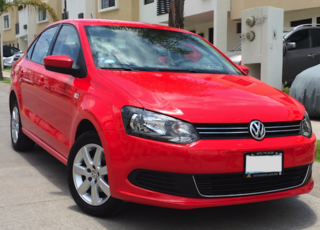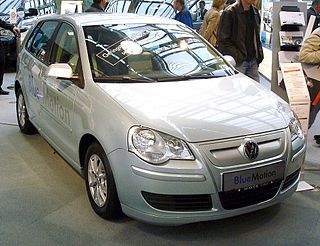Related Research Articles

Volkswagen is a German automobile manufacturer based in Wolfsburg, Lower Saxony, Germany. Established in 1937 by the German Labour Front under the Nazi Party, it was revitalized into the global brand it is today after World War II by British Army officer Ivan Hirst. The company is well known for its iconic Beetle and serves as the flagship marque of the Volkswagen Group, which became the world's largest automotive manufacturer by global sales in 2016 and 2017.

Vehicle audio is equipment installed in a car or other vehicle to provide in-car entertainment and information for the occupants. Until the 1950s, it consisted of a simple AM radio. Additions since then have included FM radio (1952), 8-track tape players, cassette players, record players, CD players, DVD players, Blu-ray players, navigation systems, Bluetooth telephone integration and audio streaming, and smartphone controllers like CarPlay and Android Auto. Once controlled from the dashboard with a few buttons, they can be controlled by steering wheel controls and voice commands.

The Volkswagen Golf is a compact car/small family car (C-segment) produced by the German automotive manufacturer Volkswagen since 1974, marketed worldwide across eight generations, in various body configurations and under various nameplates – including as the Volkswagen Rabbit in the United States and Canada, and as the Volkswagen Caribe in Mexico (Mk1).

The Volkswagen Lupo is a city car that was produced by the German car manufacturer Volkswagen, from 1998 to 2005. It shares most of its aspects with the Volkswagen Group's SEAT Arosa, both derived from the Volkswagen Polo Mk3 platform. Main differences are found in styling and equipment. The Lupo name is Latin, meaning wolf, and is named after its home town of Wolfsburg.

The Volkswagen Passat is a nameplate of large family cars (D-segment) manufactured and marketed by the German automobile manufacturer Volkswagen since 1973 and also marketed variously as the Dasher, Santana, Quantum, Magotan, Corsar and Carat — in saloon, estate, and hatchback body styles.

The Volkswagen Touareg is a mid-size luxury crossover SUV produced by Volkswagen since 2002. The vehicle is named after the nomadic Tuareg people, inhabitants of the Saharan interior in North Africa. The Touareg was originally developed with the Porsche Cayenne and Audi Q7 and as of October 2020, the Touareg was developed with the Audi Q8, the Bentley Bentayga and the Lamborghini Urus, which shares their MLB Evo platform and chassis. The first generation (2002–2010) offered five, six, eight, ten and twelve-cylinder engine choices.

An exhaust system is used to guide reaction exhaust gases away from a controlled combustion inside an engine or stove. The entire system conveys burnt gases from the engine and includes one or more exhaust pipes. Depending on the overall system design, the exhaust gas may flow through one or more of the following:

The Volkswagen Vento is a subcompact car produced by the Volkswagen India and Volkswagen Russia subsidiaries of the German manufacturer Volkswagen since 2010. It is essentially a three-box Volkswagen Polo with a stretched wheelbase and has been developed especially for some markets. The car is sold under the Vento nameplate in India, Malaysia, Brunei and Mexico. In Thailand, South Africa, Argentina, Russia, Jordan, Morocco, Algeria, Tunisia and the Middle East, it is sold as the Volkswagen Polo Sedan. The name Vento means 'wind' in both Italian and Portuguese. It is also known as the Volkswagen Polo Notch in the Philippines.
BlueTEC is Mercedes-Benz Group's marketing name for engines equipped with advanced NOx reducing technology for vehicle emissions control in diesel-powered vehicles. The technology in BlueTec vehicles includes a selective catalytic reduction (SCR) system that uses diesel exhaust fluid, and a system of NOx adsorbers the automaker calls DeNOx, which uses an oxidizing catalytic converter and diesel particulate filter combined with other NOx reducing systems.

Volkswagen Commercial Vehicles is a German marque of light commercial vehicles, owned by Volkswagen Group. It is headquartered in Hannover, Lower Saxony, Germany. Originally part of Volkswagen Passenger Cars, it has operated as a separate marque since 1995.

The Volkswagen Golf Mk3 is a medium-sized compact family car. It is the third generation of the Volkswagen Golf and the successor to the Volkswagen Golf Mk2, which was produced by Volkswagen from August 1991 to 2002.
Noise, vibration, and harshness (NVH), also known as noise and vibration (N&V), is the study and modification of the noise and vibration characteristics of vehicles, particularly cars and trucks. While noise and vibration can be readily measured, harshness is a subjective quality, and is measured either via jury evaluations, or with analytical tools that can provide results reflecting human subjective impressions. The latter tools belong to the field psychoacoustics.

BlueMotion is a trading name for certain car models from the Volkswagen Group, emphasizing higher fuel efficiency.

Electric vehicle warning sounds are sounds designed to alert pedestrians to the presence of electric drive vehicles such as hybrid electric vehicles (HEVs), plug-in hybrid electric vehicles (PHEVs), and battery electric vehicles (BEVs) travelling at low speeds. Warning sound devices were deemed necessary by some government regulators because vehicles operating in all-electric mode produce less noise than traditional combustion engine vehicles and can make it more difficult for pedestrians and cyclists to be aware of their presence. Warning sounds may be driver triggered or automatic at low speeds; in type, they vary from clearly artificial to those that mimic engine sounds and those of tires moving over gravel.

TDI is the Volkswagen Group's term for its current common rail direct injection turbodiesel engine range that have an intercooler in addition to the turbo compressor.

The Škoda Rapid is a subcompact sedan car produced by Czech manufacturer Škoda Auto exclusively for the Indian market, introduced in November 2011 and manufactured until 2021.

The Volkswagen Golf (Mk7) is a C-segment car manufactured by German automobile manufacturer Volkswagen. It is the seventh generation in the Golf series and the successor to the Golf Mk6, and was introduced in Berlin on 4 September 2012, before a public launch at the 2012 Paris Motor Show. Sales in Europe began with the model in November 2012.

An exhaust heat recovery system turns waste heat energy in exhaust gases into electric energy for batteries or mechanical energy reintroduced on the crankshaft. The technology is of increasing interest as car and heavy-duty vehicle manufacturers continue to increase efficiency, saving fuel and reducing emissions.
Active sound design is an acoustic technology concept used in automotive vehicles to alter or enhance the sound inside and outside of the vehicle. Active sound design (ASD) often uses active noise control and acoustic enhancement techniques to achieve a synthesized vehicle sound.

The Volkswagen emissions scandal, sometimes known as Dieselgate or Emissionsgate, began in September 2015, when the United States Environmental Protection Agency (EPA) issued a notice of violation of the Clean Air Act to German automaker Volkswagen Group. The agency had found that Volkswagen had intentionally programmed turbocharged direct injection (TDI) diesel engines to activate their emissions controls only during laboratory emissions testing, which caused the vehicles' NOx output to meet US standards during regulatory testing. However, the vehicles emitted up to 40 times more NOx in real-world driving. Volkswagen deployed this software in about 11 million cars worldwide, including 500,000 in the United States, in model years 2009 through 2015.
References
- 1 2 3 Webster, Larry (August 2, 2012), "The Rise of the Fake Engine Roar: To make engines sound better, some automakers are broadcasting motor noise through speaker in the cabin. Is this progress—or an affront to the purity of the engine note?", Popular Mechanics .
- 1 2 3 4 5 Colwell, K. C. (April 2012), "Faking It: Engine-Sound Enhancement Explained; How car manufacturers are giving quiet vehicles raucous engine notes", Car and Driver .
- 1 2 3 4 5 Robinson, Matt (2014), "5 Ways That Manufacturers Enhance The Sound Of Their Cars", Car Throttle .
- 1 2 3 Harwell, Drew (January 21, 2015), "America's best-selling cars and trucks are built on lies: The rise of fake engine noise", Washington Post .
- ↑ Hanson, Hilary (January 24, 2015), "Your Car's Engine Roar Might Be Totally Fake", Huffington Post .